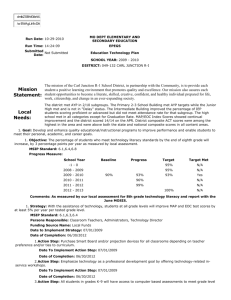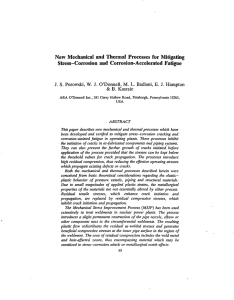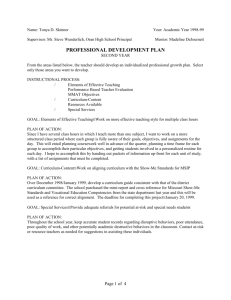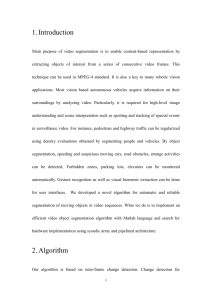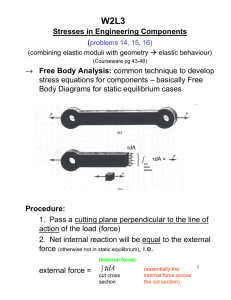to Stress Advanced Methods of Improving Resistance J.
advertisement
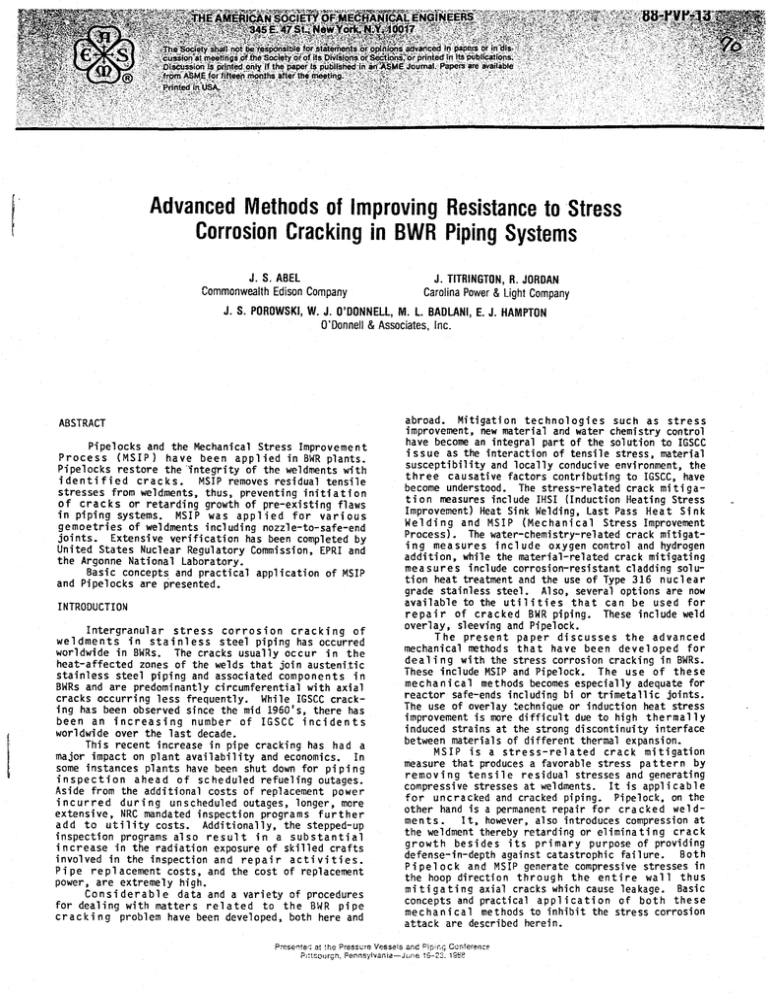
Advanced Methods of Improving Resistance to Stress Corrosion Cracking in BWR Piping Systems J. J. S. J. S. ABEL Commonwealth Edison Company POROWSKI, W. T1TRINGTON, R. JORDAN Carolina Power & Light Company J. O'DONNELL, M. L. BADLANI, E. O'Donnell & Associates, Inc. ABSTRACT Pipelocks and the Mechanical Stress Improvement P;ocess (MSIP) have been applied in BWRplants. P1pelocks restore the 'integrity of the weldments with identified cracks. MSIP removes residual tensile stresses from weldments, thus, preventing initiation ?f ~r~cks or retarding growth of pre-existing flaws 1n p1p1ng systems. MSIP was applied for various ~e~oetries of weldments including nozzle-to-safe-end Jo~nts. Extensive verification has been completed by Un1ted States Nuclear Regulatory Commission EPRI and the Argonne National Laboratory. ' Basic concepts and practical application of MSIP and Pipelocks are presented. I NTRODUCTI ON Intergranular stress corrosion cracking of weldments in stainless steel piping has occurred worldwide in BWRs. The cracks usually occur in the hea~-affected zones of the welds that join austenitic stamless steel piping and associated components in BWRsand are predominantly circumferential with axial cracks occurring less frequently. While IGSCCcracking has been observed since the mid 1960's there has been an increasing number of IGSCC incidents worldwide over the last decade. This recent increase in pipe cracking has had a major.impact on plant availability and economics. In ~ome 1nst~nces plants have been shut down for piping 1n s pe c t 10 n a hea d 0 f sc he duled refueling outages. Aside from the additional costs of replacement power incur:ed during unscheduled outages, longer, more extens1ve, NRCmandated inspection programs further ~dd to utility costs. Additionally, the stepped-up 1nspection programs also result in a substantial increase in the radiation exposure of skilled crafts involved in the inspection and repair activities Pipe replacement costs, and the cost of replacement power, are extremely high. Consi derabl e data and a variety of procedures for dealing with matters related to the BWR pipe cracking problem have been developed, both here and HAMPTON ~broad. Mitigation technologies such as stress 1mprovement, new material and water chemistry control have become an integral part of the solution to IGSCC issue as the interaction of tensile stress material susceptibility and locally conducive enviro~ment the three causative factors contributing to IGSCC,'have become understood. The stress-related crack mitigati on measures include IHSI (Induction Heating Stress Improvement) Heat Sink Welding, Last Pass Heat Sink Welding and MSIP (Mechanical Stress Improvement Process). The water-chemistry-related crack mitigating measures incl ude oxygen control and hydrogen addition, while the material-related crack mitigating measures include corrosion-resistant cladding solution heat treatment and the use of Type 316 nuclear grade stainless steel. Also, several options are now available to the utilities that can be used for repair of cracked BWRpiping. These include weld overlay, sleeving and Pipelock. The present paper discusses the advanced mechanical methods that have been developed for dealing with the stress corrosion cracking in BWRs. These include MSIP and Pipelock. The use of these mechanical methods becomes especially adequate for reactor safe-ends including bi or trimetallic joints. The use of overlay ~echnique or induction heat stress improvement is more difficult due to high thermally induced strains at the strong discontinuity interface between materials of different thermal expansion. MSIP is a stress-related crack mitigation measure that produces a favorable stress pattern by removin.g tensile residual stresses and generating compreSSlVe stresses at weldments. It is applicable for uncra~ked and cracked piping. Pipelock, on the other hand 1S a permanent repair for cracked wel dments. I t, however, also introduces compression at the weldment thereby retarding or eliminating crack growth besides its primary purpose of providing defense-in-depth against catastrophic failure. Both Pipelock and MSIP generate compressive stresses in the hoop direction through the entire wall thus mitigating axial cracks which cause leakage. Basic concepts and practical application of both these mechanical methods to inhibit the stress corrosion attack are described herein. Vessels an.c Pip!r'~1CDnfei!:!ncE Pntst)urgh, Pennsylvania-JunE": 1£0-23. 19t1B PreSEr'lte·::; at the Presst,:re J. PIPELOCK The Pipelock is a mechanical device which is designed to prevent pipe break under the assumption of a throughwall IGSCC crack around the entire circumference of the pipe weld. Pipelocks are designed to meet Secti on II I of the ASME Code for totally degraded (cracked) weldments. Pipelocks replace the weldments as the loadcarrying pressure boundary and are designed per Section III for long-term service. The analysis is typically performed for the thermal cycles given in cati on. All of the the Owner I s Des i gn Specifi stresses in the pipe wall under the grooves, including those created by the presence of the Pipelock, are consi dered [1]. The use of Pipelocks does not violate the minimum wall thickness requi red by the ASMECode. The ASMECode requires no inspection of weldments protected by Pipelocks. If inspection of weldments is desired by the utility, Pipelocks can be readily disassembled and reassembled after the inspection. The typical Pipelock with its various components is shown in Figure 1. The basic concept illustrating the equilibrium conditions and kinematic interaction of the pipe and rings resulting in self locking of the Pipelock are explained diagrammatically in Figure 2. The preloaded bolts draw the ends of the pipe together, creating axial compressive stress and circumferential compressive stress in the pipe through action of the wedges. The resulting compressive axial and hoop stresses generated by pretightening of Pipelock are shown in Figure 3. Even if the bolts were not preloaded and if the weldment were fully cracked, the axial motion of the pipes moving apart locks the entrapped wedges, preventing the ends from separating. The Pipelock design can be adapted for application to joints between pipes and pipe fittings. Also, the Pipelock can be installed on pipes with or without overlay. These points are well illustrated by two new applications of the Pipelock shown in Figures 4 and 5. Figure 4 is a Pipelock for the reactor nozzle to safe-end to pipe weldments where use of overl ay is a concern. It protects not only one, but both weldments from catastrophi c failure. Two Pipelocks for the 28" Recirculation Nozzle shown in the figure, ten Pipelocks for the riser nozzle and two core spray nozzles have been fabricated and Figure delivered to Carolina Power & Light Company. 5 is a Pipelock for an end cap weldment, which is installed on the weld overlay thereby providing safety and permitting plant operation beyond the cycles allowed with an overlay. One Pipelock of this design was fabricated and delivered to Commonwealth Edison Company's Quad Cities Plant. The field machining technology has been developed and Qualified for nominal nozzle size up to 28 inches. An inservice inspection of an installed Pipelock has been recently completed to check the Pipelock performance in actual plant conditions and to gather inservice experience. The results of the inspection confirmed that the Pipelock performed as intended in the original design. The thermal expansi on coefficient of the Pipelock studs is significantly lower than the thermal expansion coefficient of the austenitic pipe. Therefore, the Pipelock tightens as the temperature increases during startup. Due to friction, the position of the Pipelock rings reached during operation is maintained during cooldown. SHEAR RlNGS FIGURE 1 TYPICAL CROSS-SECTIONOF PIPELOCK I r--':' ~.l~-~'1 , AXIAL kING ~,,' ~~--7--7: STUDS PRELOAD, CLOSURE 1 I )...------ S >lEDGE ~J, , . ,"- RHlG LOCKING RIfIG .- , ,"---,---,,-,"' -----L..- ! , 1, , PRESSURE RADIAL PRESSURE AX IAL f" LOAD P ( LOAD PIPE FIGURE 2 EQUILIBRIUMAND KINEMATICSOF PIPELOCK OUTER PIPE SuRFACE BOG? DIRECTION INlIER PIP( STRESS (KSIl 12.0 6.0 TEflSI01l FIGURE 3 7~ f§?i~ 0.0 -6.0 -12.0 -18.0 sur-rAte lOi-iPRESS ION HOOPANDAXIAL STRESSES GENERATED THROUGH-THE-WALL IN HEAT-AFFECTED ZONEBY PRETIGHTENINGOF PIPELOCK = 1~ i'@~ :~~~JT ~Ir\ i,/~~f.~,ff', \ \, \ ..... ~.\ i" ---' ~~5i£ FIGURE 4 2 PIPELOCK PROTECTINGBIMETALLIC SAFE-ENDWELDMENTS / .. TOOL f-I . ~-'---~,I .':i.;"L;[J.' r'H:'S(?[ __ ~) FIGURE5 IF~~~'~-~=;~iIE~ j~~cL~h~:~~~::'I 1 lL _ : ENDCAPAPPLICATIONOF PIPELOCK C. AFTER SQUEEZING EITEN, \:-:'--E-t j I- FIGURE7 = l<i" '." J ' SHIH PACK SPACER OR! L STUD WASHER CONTOUR P.:NG ...••••..•. I'SER1 R:~;;~ RING- __ ~10-~ -.-.__ ~\:', r-:~""--/~ i ,/~>~/';7~T} V////l ,---'------- FIGURE6 = ~ -- Of PLASTIC ZONE -5- -)) ) BASICCONCEPT OF MSIP a. Application of Pressure b. Schematic of Equilibrium c. Compatible Deformation result in generation of residual compressive stresses at the inner pipe surface in both the axial and hoop directions. Sample contour plots indicating the stress before and after application of MSIP to the 2811 pipe are shown in Figure 8 for axial and hoop directi ons, respectively. Figures 9 and 10 illustrate the history of stress at the weldment midplane during application of the process. Application of. the process produces initial stresses, usually with1n a range of 30 to 50 ksi to generate compression of about 20 to 30 ksi. Note that the materi al at the inner surface is compressed during application as shown by the curve (3) and then after removing the tool some unloading occurs following profile (5). 'The residual compressive hoop stresses which are generated by MSIP tend to extend through the entire wall thickness. This represents a distinct advantage over thermal processes, which leave high hoop residual tensile stresses in the outer hal f of the wall, allowing deep axial cracks which leak. Note that during application of the MSIP process, the inner 1ayer of the mater i a 1 is not subje~ted to tensile strains. Moreover, MSIP does not 1mpose reversed plastic strains which can produce significant fatigue damage if thermal processes are applied. Hence it does not extend any pre-existing damage. Application of the MSIP is therefore al so appropriate for older piping systems. . MSIP is applied at ambient temperature. MSIP 1S directly verifi_able for each applicat~on simplJ by measuring circumferential pipe contract1on. S1nce the results are not related to transient temperature controls and welding parameters as in other methods introducing elevated temperature, Qualification tests are significantly easier to perform and the model s used in finite element inelastic analylsis are straightforward. There is no significant differen.ce between applying MSIP on pipes or nozzle w1th sleeves. The process can be performed with .or wi thout water inside. No cooling is needed, wh1ch - CLAMP fiLLER 1 --' TYPICALDESIGNOF MSIP TOOL Thus, after returning to ambient temperature and pressure, the original preload is reduced. However, duri ng subsequent heatup, the Pipelock retightens. This reponse was predicted analytically and confirmed by thermal testing. Pipelock therefore retains its full capacity of retarding the crack growth duri ng multi-cycle operation. MECHANICAL STRESSIMPROVEMENT PROCESS(MSIP) MSIP is a method of producing compressive stresses at the weldment by mechanical means via a hydra ul i ca 11 y actuated mechanical clamp to squeeze the pipe in the vicinity of the weldment as shown in Figure 6. The basic concept of MSIP is illustrated in Figure 7. The pipe is squeezed only locally in direct vicinity of the circumferential weld, but not at the weld itself as shown in Figure 7a. Contraction of the pipe and the position of the tool are such that the plastic zone during application of the process extends throughout the weldment. Moreover the contracted ring forces the pipe and the weld radially inward as shown in Figure 7b. ~ompatibility of the deformation along the pipe, 111 ustrated in Fi gure 7c, then requires the axial profile of the pipe in the weld root region to become concave. Thus, negative curvature and corresponding reduction of the pipe radius at the weld location 3 AXIAL BEFORE MSIF ,r [KSI] ~ , • '. T ~CS1l1t \ -10 -20 20 10KSr KSI KSI \~ ::~ HOOP AF~f;R MSIP SE,f9RLMSIP \,'="I I, ,~~0.0 : '," -20 K;SI m,/ii, ~ 11 !!X.AFTE~ MSIP [KS1] 40 -2o\:Sh K51,. Ii1 kLJL.O.O _ 120W~LDIIErIT_L::"-'k20 KSI ~ \ INSIDE OUTSIDEC--' jV ~.O II I r FIGURE 8 PIi: \ ~~)/:i -<0 I I r KS; -20 i , KSI. i ~X ;\' -40 I::SI\,' l._. --_,,:;;t"" .----o-.--_.:.-------=_.~ ..•........ ' I 1201 ,/ ~ iiiI, !!N 2 I ~ t.·. '; i ,~.:', .. '.i I 14~~~ 5 :;:;-20 ~ 0bi:~ II ./1 .. I r E; f,/l ._., ,- ..'! ~ §' _lUl. ~~./",/\ .. L -t.c~I__ 1 REDISTRIBUTION OF STRESS IN 28" WELDMENT -/ /. "":: "/ ~ / ~~~~i /' - 3· ~ __ 2 i lNlTlAL PSI LOADING 4- 3 000 fl'N"' 3 G:200 ~ 4"1. PSI P,l UNLOAOING r1AXIMU~1 ~-~--,----_~, FIGURE 10 ~ J i' Y REDISTRIBUTIONOF HOOPSTRESSES AT WELDMIDPLANE TAS:'£ I RESIDUAL STRESSES 011 THE INNER SURFA([ FOR A 12" DIAMETER PIPE WElilPlENT TREATED BY KSIP lOCAIIO~ Teol HAlTOOL SIDE POSITION Under Across Weld 2 3 I INITIAL 2 3 4 5 4,000 6,200 3,000 FINAL 4 THROUGH- THE-WAll FIGURE 9 5 PSI PSI PSI -0.59 -1.77 -4.14 -0.99 -31 DISTANCE FROM wELD -36 -15 HOOP AXIAL -34 -33 -13 -17 -17(KSll GAGE -]4 -31 0.59 -0.20 -2.57 -35 -16 -48 -15 -34 -3.35 0.20 -26 STRESS CENTERlINE STRESS (IN.) (KSIl HAZ LOADING MAXIMUM UNLOADING 6 9 NODES ~ REDISTRIBUTION OF AXIAL STRESS AT WELDMIDPLANE TOOL POSITION ~ not only dramatically simplifies the process with respect to thermaly induced improvements, but also facilitates scheduling problems duri ng short-term outages. The effect of MSIP on nozzle-to-safe-end wel ds wi th thermal sleeves welded to the inside surface of the safe-end has been examined. The tool design and confi guration have been selected to either minimize stresses at the thermal sleeve welds, or to produce compression at the susceptible locations. The process has been extensively verified by tests on weldment specimens ranging from 10" in diameter to 28" in diameter. Independent residual stress measurements on the 12" and 28" specimens have also been performed at Argonne National Laboratory and on a precracked 28" pipe-to-elbow weldment at the EPRI-NDE Center, At ANL. residual stresses on MSIP treated 12" and 28" weldments were measured on the inner surface as well as through the wall. The stresses on the inner surface were highly compressi ve in both the axial and hoop directions ranging from -30 ksi to -50 ksi in the HAl for the 12" weldment and from -22 ksi to -50 ksi in the HAl for the 28" weldment. The stress measurements for the 12" wel dment are summarized in Table I. The residual stress measurements were taken at two azimuthal locations. The stresses di d not di Her significantly and the average values for a given axial position are those shown in the Table. Throughwall axial residual stress distributions were almost linear across the thi ckness near the HAls and the compressive stresses OUTSIDE ® MSIP 12" AXIAL STRESS DEPTH 1.0 0.9 0.8 GAGE POSITION 2 0.7 0.6 0.5 0.4 Lo.3 o 1---...•... --:0....-50 -40 -30 -20 0.2 0.1 +-'0.0 -10 0 5TRESS FIGURE 11 L!. 10 i 2 4 000 20 30 40 (KSIl MEASURED THROUGH-THE-WALL DISTRIBUTION OF RESIDUALAXIAL STRESS AFTER MSIP 25% were found to persist for almost 50% of the wall thickness. Figure 11 shows the through wall axial 12" residual stress distribution in the HAl for the we1 dment. Simil ar results were found for the 28" weldment. At EPRI-NDE Center, MSIP was applied to a 28" precracked pipe-to-elbow weldment. The specimen was artifica11y precracked to generate four circumferential flaws in the HAl. These circumferential flaws were approximately I" long and extended 10%, 25%, 50% and 90% through-the-wa 11. A secti on of the spe c i me n illustrating the flaw dimensions is shown in Figure 12. Residual stresses measurements were made before and after MSIP. The specimen was also extensively strain-gaged to monitor the strains during appl i cation of MSIP. No flaw growth occurred at any time during appl ication or after treatment. This was expected since unlike the thermal processes which induce tension in the inner layer of weldment material during the first phase of the process, MSIP maintains the inner half of the wall under compression throughout the process. The strains monitored during the application of the process confirmed this and verified that at no time did the weld and HAl region to into tension. Also, the residual stress measurements showed that the as welded axial and hoop tensile stresses in the weld and HAl had been replaced by favorable axial and hoop compr~ssicn due to MSIP, Fi gure 13. The process has been applied in three Commonweal th Edi son Company plants on weldments ranging from 4" in diameter to 24" in diameter and has al so been applied at the Carolina Power & light Brunswick plant. A significant advantage of MSIP is its simplicity and effectiveness. However, in addition, it is especially suitable for treati ng nozzl e safe-end weldments where use of a thermal process is a re"a1 concern. Thirty-three of the wel dments treated at the LaSalle II unit were nozzle safe-end weldments. Also, the weldments treated at Brunswick were sixteen nozzle-to-safe-end weldments from 4" to 28" in diameter. A specially designed hydraulic box press for bringing the clamp halves together as shown in Figure 14 is used to squeeze heavy wall nozzles and large diameter pipes. The tool and presses are assembled outside the bioshield and then moved into position using a delivery system. Box presses assembled in the mockup of bioshield door is shown in Figure 15. MSIP is now recognized and accepted by NRC as equi valent to IHSI (NUREG0313, Rev. 2). While both processes are technically acceptable, a recent utility perspecti veon the comparison of MSIP vs. IHSI [Ref. 2J judged MSIP to be less labor-intensive, requiring much less craft support and resulting in significantly less radiation exposure. In summary, the basic mechanics, including the use of only applied compressive strains, the simplicity of application (no water required in pipes), the verifiability of MSIP, combined with its greater effectiveness in inducing compressive residual strains as well as stresses, provide significantly greater reliability and safety than any other current technology. /1 ; /1 II i i ::; ....--.....------=b-V/N . i ._L_ 90~ " ELBOW NOT TO MS I P SCALE = DIMENSIONS FIGURE 12 • TOOL ZONE 28" PRECRACKED SPECIMEN: MSIP ARTIFICIAL FLAWDETAILS SHOWINGTYPICAL FLAWCROSSSECTION PRIOR TO MSIP -, ----, Ii BEFORE MSIP I :~ /i~ I :~/~ ~ •... 0 -10 '" -20 -30 -40 !' INCHES ;~l 60 5.00 END I ./ -50 -60 -70:--:::-r--i---'~"---,---,---r--,~-r-..--,----r-r--l -2.00 0.00 2.00 o 4.00 DISTANCE AXIAL 6.00 FROM 8.00 WCl + 10.00 12.00 (IN.) HOOP 80 70 AFTER 60" MSIP 50 40 30 20 10 ~ 0 a: -10 ! In -20 -30 '1 =:~ -~ ~-r--~-~=~~L-.--2.00 0.00 2.00 o FIGURE 13 5 4.00 DISTANCE AXIAL I 6.00 FROM WCL + B.OO "__ ~.J 10.00 12.00 (IN.) HOOP RESIDUALSTRESSES MEASURED AT INSIDE SURFACEOF 28" WElDMENT REFERENCES 1. "Applicability of Pipelocks as a Remedy for Intergranular Stress Corrosion Cracking in BWRs," EPRI NP-3849-LD, T302-3, Final Report, December 1984. 2. "Seminar on Pi pe Repair and Replacement: An Update," co-sponsored by EPRI and BWROwner's GroupII. Charlotte. North Carolina. October 1987. r-rr I ~' .. ~ + I I: I i ,/ ~ ,i FIGURE 14 - / ../. /.~~/ i I + MSIP 24" TOOL WITH BOX PRESSES FIGURE 15 TRAINING MOCKUPFOR SQUEEZINGOF SAFE-ENDS 6
